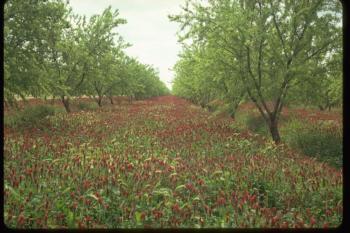Nitrogen From Organic Sources
Perhaps one of the most difficult components of a nitrogen budget is determining how much N will become available for crop uptake from organic sources, including crop residues, manure, compost and native soil organic matter. Several factors determine how much N will be released, or mineralized, from organic materials including: the organic N content and state of decomposition, percent N (by weight), carbon to nitrogen ratio (C:N ratio), and soil conditions (such as temperature and moisture content). A more in-depth look at integrating organic sources of N into your nutrient management can be found here or by using visiting our Focus Topic page.
Cover Crops: In California, cover crops are often utilized during the wet winter months. Cover crops have been shown to have a wide variety of beneficial effects on soil quality. For more information on cover crops, visit our cover crop page or, for a more in-depth discussion on selecting and implementing cover crops, use this book.
- Legumes: Although there are many potential soil benefits from cover crops, only leguminous cover crops can convert atmospheric nitrogen gas into a biologically-available form. When leguminous cover crops are terminated, they will contribute 100-200 lbs N/ac of organic nitrogen1, which can then mineralize into plant available nitrogen. The majority of this mineralization can occur in several weeks if the cover crops are incorporated, but will take longer if the residues are mowed and left on top of the soil1.
- Non-legumes: Although they do not necessarily fix atmospheric nitrogen for use by plants, non-leguminous cover crops can be used to prevent residual nitrogen from leaching beyond the root zone2. After being incorporated into cover crop biomass, this nitrogen can then be recycled for cash crop use after the cover crop is terminated. In addition to these improvements in nitrogen use, non-leguminous cover crops also have the potential to contribute to overall soil health.

Compost: Compost is defined as the material resulting from the controlled biological decomposition of organic material3. There are many benefits to compost, including many improvements in soil health4,5 and nutrient supply of a soil, as well as other non-nutrient related benefits, such as pathogen suppression and the ability to keep pollutants out of the environment.
In addition to nitrogen, compost also has the ability to provide crops with phosphorus (P) and potassium (K). In fact, due to high P and K availability in some composts, using compost to manage strictly for nitrogen can often result in overfertilization of P and K6. To estimate amount of N, P, and K that will be made available from your compost in the first year after it is applied, you can use this worksheet.
Manures: The nitrogen present in manures is usually in the form of organic N, which means that much of it must be mineralized in the soil before becoming plant available. The range of mineralization rates can be quite variable, depending on the age and quality of the manure being applied. Up to 50% of the applied organic N from manures can become plant available within the first year it is applied, but that value substantially drops to 15% or less in the second year. To calculate N availability from manures for crops in successive growing season, use this worksheet to adjust fertilizer application rates accordingly.
Soil Organic Matter: The decomposition of native soil organic matter, a process known as mineralization, can be a significant contributor to plant-available nitrogen throughout a season. Recent studies have shown upwards of 50% of plant N uptake to be derived from soil7,8. Some of this soil-supplied N was likely in the form of inorganic nitrogen, such as nitrate or ammonium, but the majority was likely derived from the breakdown of already-present (or native) soil organic matter. To estimate approximate mineralization rates according to your soil temperature, growing region, and soil organic matter content, you can visit this page. If you do not know your soil organic matter content, you can convert between soil carbon or soil organic carbon content from soil test results. To calculate % soil organic matter content, you can divide soil carbon % by 0.58. For more information on the factors that can affect the rate of mineralization of organic materials in soil, you can visit our focus topic.
References
1. Ingels, C., Horn, M., Bugg, R., & Miller, P. (1994). Selecting the right cover crop gives multiple benefits. California Agriculture, 48(5), 43-48.
2. Clark, A. (Ed.). (2008). Managing cover crops profitably. DIANE Publishing.
3. U.S. Composting Council (2008). Compost and its benefits. http://compostingcouncil.org/admin/wp-content/uploads/2010/09/Compost-and-Its-Benefits.pdf. Accessed March 11, 2016.
4. Stamatiadis, S., Werner, M., & Buchanan, M. (1999). Field assessment of soil quality as affected by compost and fertilizer application in a broccoli field (San Benito County, California). Applied Soil Ecology, 12(3), 217-225.
5. Brown, S., & Cotton, M. (2011). Changes in soil properties and carbon content following compost application: results of on-farm sampling. Compost Science & Utilization, 19(2), 87-96.
6. Hartz, T. (2009). Nutrient Value of Compost. University of California Organic Soil Fertility Management Symposium, Davis, CA. January 15, 2009.
7. Stoecker, A. L., & Onken, A. B. (1989). Optimal fertilizer nitrogen and residual nitrate-nitrogen levels for irrigated corn and effects of nitrogen limitations: An economic analysis. Journal of Production Agriculture, 2(4), 309-317.
8. Kramer, A. W., Doane, T. A., Horwath, W. R., & van Kessel, C. (2002). Short-term nitrogen-15 recovery vs. long-term total soil N gains in conventional and alternative cropping systems. Soil Biology and Biochemistry, 34(1), 43-50.
9. Doane, T. A., Horwath, W. R., Mitchell, J. P., Jackson, J., Miyao, G., & Brittan, K. (2009). Nitrogen supply from fertilizer and legume cover crop in the transition to no-tillage for irrigated row crops. Nutrient cycling in agroecosystems, 85(3), 253-262.
